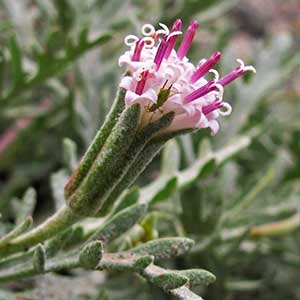Chaenactis thompsonii
Chaenactis nevadensis
Thompson's pincushion
Nevada dustymaiden, Sierra chaenactis, Sierra pincushion
mostly 5–15+, ascending to erect.
mostly 10–20+, decumbent to ± erect.
mostly cauline, 2–5 cm;
largest blades ± elliptic, ± plane, 1-pinnately lobed;
lobes mostly 2–5 pairs, remote, ± plane.
± basal, 2.5–5 cm;
largest blades ovate to deltate, ± plane, (1–)2-pinnately lobed;
primary lobes mostly 2–4 pairs, ± congested, ultimate lobes ± plane.
ascending to erect, 2–5 cm.
mostly ascending to erect, (0.5–)3–11 cm.
± obconic.
obconic to ± cylindric.
7–9 mm.
5.5–8 mm.
longest (10–)12–15 mm;
outer closely lanuginose, not stipitate-glandular, apices erect, ± rigid.
longest 9–12(–14) mm;
outer stipitate-glandular, apices erect, ± rigid.
mostly 1–3 per stem.
1(–2) per stem.
7–9 mm (eglandular);
pappi: longest scales 3.5–5 mm.
5.5–7.5 mm;
pappi: longest scales 3–5 mm.
= 12.
Chaenactis thompsonii
Chaenactis nevadensis
Of conservation concern.
Chaenactis thompsonii appears to be sister to C. evermannii; it is known from the mountains of central and northwestern Washington. The similar habits of C. thompsonii and C. ramosa (= C. douglasii var. douglasii) appear to result from convergent evolution in the distinctive habitat of their type localities (Wenatchee Mountains), not from a close genetic relationship as suggested by Cronquist.
(Discussion copyrighted by Flora of North America; reprinted with permission.)
Chaenactis nevadensis is known mainly from the northern Sierra Nevada and southern Cascade Range (Shasta to Placer counties, California; Washoe County, Nevada). It was recently discovered disjunct on ultramafic rocks of Bully Choop Mountain west of Redding, California, where it approaches small forms of C. suffrutescens in habit (see discussion there). It is sometimes cultivated in rock-gardens and may be found beyond its native range. Chaenactis nevadensis and C. suffrutescens appear to be sister or ancestor-derivative species. I have seen no evidence to support reports that C. nevadensis intergrades with C. alpigena (P. Stockwell 1940, as C. nevadensis var. mainsiana), with C. douglasii var. alpina (M. Graf 1999), or with any other taxon.
(Discussion copyrighted by Flora of North America; reprinted with permission.)


